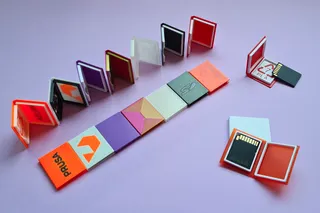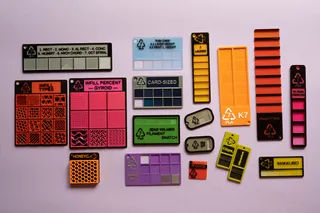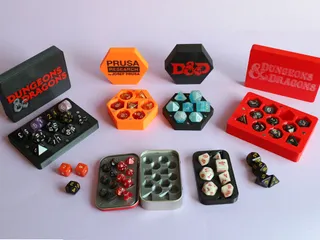3000+ Token Stands
Description
PDFUPDATE: Since it seems that Printables is having trouble showing the “download all files” button (maybe I broke something, ups!), I've added six zip files at the “Other files” section (bottom), with all the files split in 3 parts per slot size (3 zips for 0.25mm slot, 3 zips for 1.5mm slot).
Here's a very extensive set of standees or holders for cards, 2D printed minis, tokens and even desktop notes —which is useful, as you can pass your DIY minis as “office supplies”.
The variants are as follows:
- There are 2 slot sizes (distance between the prongs of the clip):
- 0.25mm, for cardstock and photographic paper (1-sided or even 2-sided)
- 1.5mm, for thicker punchouts, plastic pieces or encapsulated cardstock (like the Printables logo here, which is 3D printed)
- There are 42 shapes:
- Round
- Square: straight, rounded, “chamfered” (with quarter-circles cut from corners) and "diamond" (rotated 45 degrees and fit into the allowed space).
- Hexagonal (straight and rounded). The different sizes (q.v.) are not bigger/smaller hexagons, but hexagonal patterns following the optional rules for hex grids in the Source Reference Document (SRD) used for D&D and Pathfinder (and many others).
- Rectangular (in 2x1 and 3x2 ratio, and both straight and with chamfered corners).
- Pill, in both 2x1 and 3x2 ratio. (A “pill”, or circum, is a square/rectangle with two half-circles added at opposite sides, or a rectangle with the shorter sides fully rounded.)
- Oval or ellipse (in 2x1 and 3x2 ratio)
- Octagon (straight and rounded)
- Triangle (straight and rounded)
- Pentagon (straight and rounded)
- Heptagon (straight and rounded)
- Nonagon (AKA enneagon; straight and rounded)
- Decagon (straight and rounded)
- Dodecagon (straight and rounded)
- Hexadecagon (that's 16 sides; straight and rounded)
- Cross (both in “St. George's” or “+” straight cross, and "St. Andrew's" or spot-marking X cross)
- Rhombus of the hexagon-making type (120 and 60 degree angles; alternatively, you can use it as an isometric mapmaking template).
- Teardrop (in 2x1 and 3x2 ratio)
- Slice or “wedge” (as in Trivial Pursuit), in 1x1 and 3x2 ratio.
- Heart
- 5-sided star
- Arrow
- 6-petal flower
- Borders have 6 different styles:
- Straight, with the rim in a straight angle with the holder top.
- Beveled, with sloped border
- Curved, with smoothed top rim
- Incurved, with a torus cutout from the rim (that is, with a smooth indent)
- Smooth, with bottom and top smoothed (circle section)
- Stepped, with the top slightly recessed, like those pawns from a game about a quest of some heroes.
- Token stands come in 6 different sizes that correspond with the sizes in SRD 3.5/5.0 used by D&D and Pathfinder (but about sizing, see below):
- Tiny, with a reference size of 12.5mm
- Small/Medium, with reference size of 25mm
- Large, reference size of 50mm
- Huge, for 75mm of reference size
- Gargantuan for a rounded 100mm (10cm) of reference size, and
- Colossal(-ish), for a greater-than-DVD reference size of 125mm (yep, 125 and not 150; see below).
Note that the clip shape allows the insert to “lean” a bit if there is some room for wiggling; that is, you don't need to fit the exact measurements. Also, paper (and cardboard, cardstock…) has much give, so you can fit more than one sheet in the thin slot. Long story short, the two slot sizes can work for more things than one would think at first.
About size
As you see, basic size is 25mm metric (not the 25.4mm of an inch) and each stand has a “clutch” or clearance of 0.1mm by side; this will help you see the grid and have large arrays or armies withouth having to worry about overstepping on another square. So, for instance, a Gargantuan side will be 99.8mm (instead of 100 or 101.6).
Colossal is some kind of oddity. First, is a Pathfinder-only size (which would be 30ft. side, or 6 squares), and second, the hex grid footprint is not 6, but 5 hexes (or 25ft, not 30); so we consider it to be 125 and not 150mm of side; but feel free to scale X and Y by 120% if you really need a 150mm token holder (which may be more of a pizza plate and less of a holder, but anyway…). This “small Colossal” may work nicely with some of the biggest Gargantuan-sized paper miniatures, just as Huge is sometimes a better fit than Large (we didn't get really rid of “tall” and “wide” large/huge, after all…). YMMV, but you have options.
Sizes for even-sided n-gons are measured by the distance “from flat to flat” (apothem x 2), whilst for the odd-sided n-gons are measured by their greatest width (and thus protrude from the facing vertex, whilst even-sided protrude from the flank vertices). Slot orientation is placed taking into account the “facing” rules in SRD when possible. The “rounded” versions of the n-gons fit in the same footprint as the non-rounded ones.
You might notice that the Tiny size of certain variations of the narrower 2x1 shapes for 1.5mm slot are missing (beveled, incurved, stepped); there simply no is room for the prongs with the border removed.
Printing & processing tips
The 0.25 slot may end up “clogged” on one side, due to seams/retractions/stringing/etc. If so, just pass gently the blade of a hobby knife through the slot with a saw-like motion; do not use your sturdy working knife, it will be too thick. The flex of the clip will depend, of course, on the material; use PLA if you want it mostly rigid, and PETG, PP or PVB well soaked in IPA after printing if you want more flexibility. Obviously, TPU will have the greater flex, but it may be too much.
You may also cut the clip if you just want some good ole miniature bases. Just so you know, the clips start at z=3.125mm, which may seem an odd measure, but is exactly 1/8 of the basic unit and also allows for a bit of flexibility when it comes to adaptive layer heights and z-based color changes. You might also cut the clip, separate it into parts and move them if you need another slot width not presented here, but this may be a bit trickier.
Clips are 8mm tall in total, 5 mm to the narrowest part and 3mm over it; the bottom part of the clip is slightly over 5mm long (about like 5.6), so you can use it to add 5mm labels.
The paper minis seen in the pictures are from Printable Heroes. They do not sponsor nor endorse these stands, but they do indeed offer a great variety of models —many of them for free. They do also have several, very affordable Patreon tiers —I suggest to check them out!
Tags
Model origin
The author marked this model as their own original creation.




